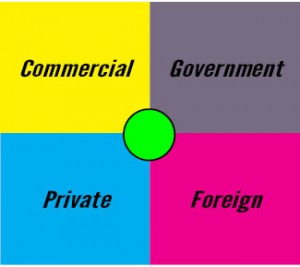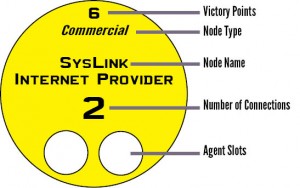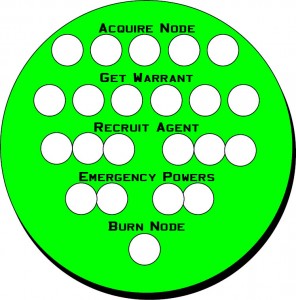Another week brings us another random game! Again, for those of you just joining us, these random games are little more than pitches. They’ve never been played and may in fact be shockingly unplayable. But they’re a fun thought exercise. And who knows, one of them may actually turn out to be a real game some day.
Today’s entry is Wiretap. Its random game idea came from Boardgamizer, which gave me the following:
Mechanics: Worker Placement, Crayon Rail System
Theme: Illuminati
Victory: Victory Points
As an added bit of randomness, I checked in with the Struct Game Idea Generator , which gave me one more suggestion: “A game with Wires and Growth.”
Deep breath. Okay. Here we go.
Overview
Each player controls a rival intelligence agency inside a paranoid police-state government, and is competing to grow the largest wiretapping network. Over the course of the game, they score points by creating connections to “nodes” like traitor’s homes and suspicious businesses. Officially, they need warrants for each connection they create, but they can ignore this and press their luck if they wish. The game ends when the last “Score” card is drawn, and the player with the most points wins.
Components
- Crayons: Each player has his own color of erasable crayon.
- Game Board: The board is divided into four quadrants. Each quadrant corresponds to a type of entity that the players wiretap: commercial, private, government, and foreign. At the center of the board is the Central Node, which has printed on it several actions you can take.

- Node Cards: The round cards represent the various people and locations that the agencies are wiretapping. (I don’t really like the term “node” because it feels more technical than it should, but didn’t come up with anything better in the time allotted. Suggestions are welcome in the comments.) Node cards are shuffled into a deck, some of them start in play, and all of them have a number of attributes:
- Victory Points: How many points the node is worth, both when you connect to it and when you score it throughout the game.
- Node Type: Whether it’s commercial, private, government, or foreign determines where the card comes into play.
- Number of Connections: Different nodes can support different numbers of connections. You might be able to wiretap a lone activist only once, but able to drop a half-dozen taps on the casino where criminals hang out.
- Agent Slots: To create a connection to a node, you need to play an agent to it (i.e., place a worker there). You play agents in these slots. If there are no open slots, you can’t play an agent there.

- Warrant Counters: To stay legal, you need to have at least as many warrants as you do connections. Each warrant counter represents a warrant.
- Agents: Each player has 10 “agent” counters. (I’m seeing meeples, but they could be anything.) You start with 5, but can get more over the course of the game.
Playing the Game
On your turn, you can take one action. To take an action, you must allocate at least one of your agents to do so. If you have no unallocated agents left, you can take no actions. Here are the actions:
Create a Connection: To create a connection, play an agent into the empty agent slot of a node, then draw a straight line on the board between that node and either another node you’ve already connected or the Central Node. Note that you can’t create a connection between two nodes if either node is already at its maximum number of connections, or if they can’t be connected by a straight line that doesn’t cross another node. You must be able to trace a route from the node back to the Central Node. Score points equal to the VP of the nodes you have just connected.
Acquire Node: Play an agent onto the “acquire node” slot on the Central Node to reveal the top card of the node deck. If it’s a normal node, put it onto the board where ever you want within its quadrant. (So a “private” node would go in the “private” quadrant.) If it’s a normal node, you may immediately take another action to create a connection to that node, if you have an agent available.
- If it’s an “Internal Audit” node, the game pauses while everyone checks to see if they have more connections than warrants. If they do, they must erase connections until they have no more connections than warrants.
- If it’s a “Score” node, everyone scores the victory points for each node to which they have a connection. When the fourth “Score” node comes up, everyone scores normally, but then the game ends.
Get Warrant: Play an agent onto the “get warrant” slot on the Central Node to receive a warrant counter.
Recruit Agent: Play three agents onto the “recruit agent” slot on the Central Node to add another agent to your pool.
Emergency Powers: Play two agents onto the “emergency powers” slot on the Central Node to get four warrant counters.
Burn Node: Play an agent onto the “burn node” slot on the Central Node to remove a node from play. Any agents on that node are removed from play, and any connections that are left hanging without that node are destroyed. Note that the agent played to this slot will also be removed from play.
When no one has any more actions to take, the round ends. Everyone retrieves at least one agent, the role of first player rotates to the right, and a new round begins. (Exception: If there’s an agent in the “burn node” slot, it isn’t retrieved, but is removed from play.)
Game End and Winning
See “Score Node,” above. That pretty much covers it.
Analysis: Game Design Challenges
- Too Many Agents: Whenever you have an action economy, and one of the actions you can take is “get more actions,” there’s a chance it might blow up in your face. With the high cost of gaining agents, and the possibility of losing them through the Burn Node action, I think it’ll be okay, but that would be the first thing I’d focus on in playtesting.
- How Many Nodes: I’m sure there’s a perfect number of node cards to keep the board full enough to be interesting, but not over-cluttered. I have no idea what that number is, but it’s got to be there somewhere.
- Warranted Action: The point of the warrants mechanic is to introduce a bit of chance and press-your-luck to the game. But if warrants are too easy or too hard to get, they become irrelevant or frustrating. And maybe the game has enough depth to be fun and challenging without that bit of chance and luck-pressing. The only way to find out is to actually prototype it up and play it.
Analysis: High Points
- New Points: I’m sure this isn’t the first game to use crayons in a non-railroad scenario, but it might be the first to let players place the points between which they create the routes. I don’t know if folks are clamoring for innovation in crayon-based mechanics, but it’s something to look into.
- Connecting the Dots: Yes, players can always just make connections between the Central Node and whatever node they want to wiretap. But because they get points for both nodes they’re connecting (and the Central Nodes doesn’t give points), the game encourages them to expand outward, growing the board in their quest for victory points.
- End State: I like sticking the game-end into the node deck. It’s a classic mechanic for a reason: it keeps players from knowing exactly when the game is going to end, and keeps the game end within the natural cycle of game play.
Two random games in two weeks. Can I keep up this break-neck pace? Check back next week and we’ll find out together!



